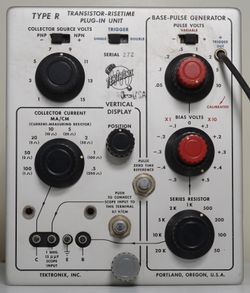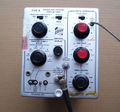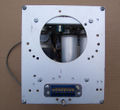R: Difference between revisions
No edit summary |
No edit summary |
||
| Line 9: | Line 9: | ||
designers=| | designers=| | ||
manuals= | manuals= | ||
* [ | * [[Media:070-286.pdf|Tektronix Type R Manual]] (PDF) | ||
* [http://bama.edebris.com/manuals/tek/r/ Tektronix Type R Manual | * [http://bama.edebris.com/manuals/tek/r/ Tektronix Type R Manual @ BAMA] | ||
<!-- * [http://w140.com/tek_fcp/tek_type_r_factory_cal_proc.pdf Tektronix Type R Factory Calibration Procedure (PDF)] --> | <!-- * [http://w140.com/tek_fcp/tek_type_r_factory_cal_proc.pdf Tektronix Type R Factory Calibration Procedure (PDF)] --> | ||
* [[Media:tek_type_r_fcp.pdf|Tektronix Type R Factory Calibration Procedure (PDF, OCR)]] | * [[Media:tek_type_r_fcp.pdf|Tektronix Type R Factory Calibration Procedure (PDF, OCR)]] | ||
}} | }} | ||
The '''Tektronix Type R''' is a plug-in for [[500-series scopes]]. | The '''Tektronix Type R''' is a plug-in for [[500-series scopes]]. | ||
It is designed to measure risetime of a NPN and PNP transistors, | It is designed to measure risetime of a NPN and PNP transistors, but it works well with FETs as well. | ||
but it works well with FETs as well. | |||
Type R can operate in grounded-emitter or grounded-base configurations. | Type R can operate in grounded-emitter or grounded-base configurations. | ||
In the grounded-emitter configuration, it provides a variable collector voltage through a collector resistor | In the grounded-emitter configuration, it provides a variable collector voltage through a collector resistor which is used to sense the collector current. | ||
which is used to sense the collector current. | It provides a base bias voltage and a base pulse signal, fed to the base of the transistor through a resistor. | ||
It provides a base bias voltage and a base pulse signal, | The base pulse is generated by a [[mercury switch]] and its rise time is specified to be less than 5 nanoseconds. | ||
fed to the base of the transistor through a resistor. | |||
The base pulse is generated by a [[mercury switch]] | |||
and its rise time is specified to be less than 5 nanoseconds. | |||
Base and collector bias conditions can be set independently. | Base and collector bias conditions can be set independently. | ||
The collector signal is AC-coupled to | The collector signal is AC-coupled to an amplifier whose output is fed to the oscilloscope. | ||
an amplifier whose output is fed to the oscilloscope. | The Type R has its own on-board low-voltage, high-current regulated power supplies which feature germanium power transistors. | ||
The Type R has its own on-board low-voltage, | |||
high-current regulated power supplies which feature germanium power transistors. | |||
Type R was [[introduced in 1958]], along with the [[551]], [[533]], and [[543]] mainframes, | Type R was [[introduced in 1958]], along with the [[551]], [[533]], and [[543]] mainframes, | ||
Revision as of 09:21, 20 August 2021
The Tektronix Type R is a plug-in for 500-series scopes. It is designed to measure risetime of a NPN and PNP transistors, but it works well with FETs as well.
Type R can operate in grounded-emitter or grounded-base configurations. In the grounded-emitter configuration, it provides a variable collector voltage through a collector resistor which is used to sense the collector current. It provides a base bias voltage and a base pulse signal, fed to the base of the transistor through a resistor. The base pulse is generated by a mercury switch and its rise time is specified to be less than 5 nanoseconds. Base and collector bias conditions can be set independently.
The collector signal is AC-coupled to an amplifier whose output is fed to the oscilloscope. The Type R has its own on-board low-voltage, high-current regulated power supplies which feature germanium power transistors.
Type R was introduced in 1958, along with the 551, 533, and 543 mainframes, and the Type H plug-in. It is the first plug-in with transistors. It was dropped after 1966.
Pictures
-
Type R plug-in with fixtures
-
-
-
-
-
-
-
-
-
-
Late serial number Type R
-
Late serial number Type R
-
Late serial number Type R
-
Late serial number Type R
-
Late serial number Type R
-
Late serial number Type R
-
Type R with 386-852
-
386-852, 386-853, 386-854, 386-855, 386-856, and 386-857 fixtures for use with Type R.


















